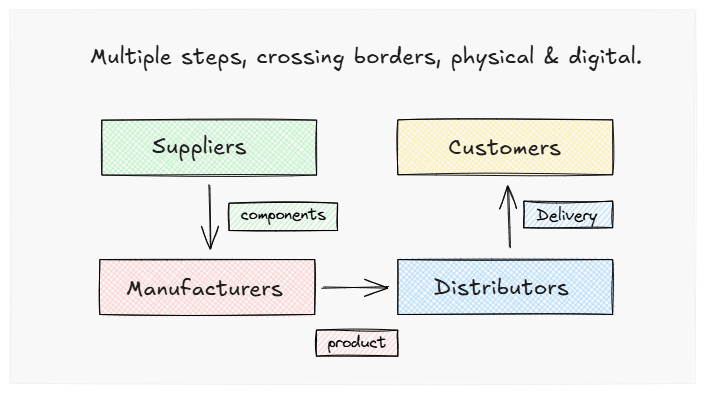Supply Chain Attacks: The Essential 2025 Guide to Unstoppable Defense

Cybersecurity isn’t about protecting just one company. It’s about keeping an entire web of relationships safe; including suppliers, partners, and vendors that work together to help businesses run smoothly. These connections—while essential for modern business efficiency—simultaneously create weak spots that attackers can take advantage of (i.e., supply chain attacks), using trusted paths to sneak into target organizations. Understanding how these supply chain attacks work helps businesses better prepare and protect themselves against these sneaky, high-impact threats.
Understanding how these attacks work helps businesses better prepare and protect themselves against these sneaky, high-impact threats.

What is a Supply Chain?
The supply chainis basically the team of companies, people, and processes that work together to get a product or service from the point of origin (raw materials or initial code) to the final customer. This includes suppliers, manufacturers, logistics providers, distributors, and, critically, software and service providers (vendors). It often stretches over different countries and includes many digital and physical steps.
In the context of cybersecurity, the supply chain becomes an extended attack surface. Attackers exploit the inherent trust between an organization and its partners. They do this by sneaking in malware or malicious code into software or services that companies consume or trust. Once inside a trusted partner’s network, they can leverage that relationship to move laterally and cause damage across several connected businesses. This is often called a cascading attack because the failure of one system quickly spreads to others. This cascading effect is the primary risk profile of supply chain attacks.

How to Spot Supply Chain Attacks
- Software/Code Tampering: This involves inserting malicious code into legitimate software during the development, build, or update process. The SolarWinds incident is the definitive example of this technique.
- Hardware Tampering: Less common but potentially more devastating, this involves physically modifying hardware components (like chips or network devices) at the manufacturing stage before they reach the customer.
- Human/Process Exploitation: Attacking a vendor’s internal team using social engineering or phishing to steal credentials and gain access to the distribution platform, which is then used to push malicious updates.
Vendor Risk & Detection: How to Spot Supply Chain Attacks
- Watch for Strange Behavior: Keep an eye out for unusual activity originating from trusted, yet unexpected, sources. This could include unexpected file transfers, strange network traffic patterns (especially connecting to new, unknown external IPs), or sudden, unapproved system changes.
- Secure Software Practices: Enforce the use of tools like code signing (cryptographically verifying the publisher of software) and Software Bills of Materials (SBOM) to make sure the software coming in is legitimate and hasn’t been tampered with. An SBOM provides a complete, auditable list of all components and dependencies in a piece of software.
- Vendor Risk Vetting (Continuous Assessment): Before and during any partnership, look closely at how seriously they take security (Time-to-Remediate, internal governance). Don’t rely solely on annual SOC 2 reports; identify and track any known weak points continuously.
- Look for Anomalies: Use technology like AI-powered User and Entity Behavior Analytics (UEBA) to notice behavior that doesn’t fit normal patterns. This includes weird login attempts from a vendor account (e.g., login from two different continents in one hour) or odd system use that deviates from the vendor’s agreed-upon service scope.
How to Prevent Supply Chain Attacks
- Carefully Evaluate and Contract: Carefully evaluate your suppliers and vendors before teaming up. Have clear contracts that spell out mandatory security expectations, including requirements for least-privilege access, Multi-Factor Authentication (MFA) enforcement, and regular, third-party security checks.
- Strengthen the Human Layer: Train your employees to recognize phishing and social engineering tricks. Attackers frequently use vendor impersonation scams (like the secondary wave seen in the CDK Global incident) to start attacks. Continuous, scenario-based simulation is key.
- Ensure Segmentation: Implement strong network segmentation. Vendor remote access should be isolated from internal core dealer networks and mission-critical systems. If a vendor is compromised, this prevents the malicious activity from immediately spreading laterally across your organization.
- Patch Management: Keep all your software and systems updated to patch any security holes. Prioritize patching systems that interact directly with external vendors or handle software distribution.
- Evidence-Backed Vetting: Require time-to-evidence commitments from vendors. When something goes wrong, they must quickly produce verifiable artifacts (timelines, takedown receipts, before/after screenshots) you can show to auditors and insurers.
Some Well-Known Supply Chain Attacks
- High-profile supply chain attacks like SolarWinds (2020): Hackers inserted a backdoor into a software update from SolarWinds, which infected thousands of organizations, including government agencies and big companies.
- CCleaner (2017): Attackers put malware into updates for CCleaner software used by millions worldwide, gaining access and stealing data.
- NotPetya (2017): Malware that started in Ukraine spread through infected software updates and caused massive disruptions in many industries globally.
Challenges and What Can Help
Because supply chains are complicated and full of trusted partners, it’s hard to spot attacks quickly. But by getting better at checking risks, sharing information openly, and having strong security measures, companies can get better at spotting and stopping these attacks.
What is a supply chain attack?
It’s when hackers target a company’s vendors or suppliers instead of attacking the company directly to gain access to its systems.
Can you give an example?
The SolarWinds hack in 2020 is a clear example, where attackers used a software update to access thousands of organizations worldwide.